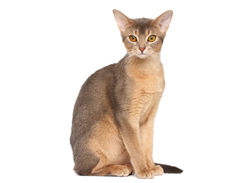Abyssinian cats, referred to as Abys for short, have long, sleek, muscular bodies and oversized, pointed ears. They're one of the oldest known cat breeds and still bear a striking resemblance to felis lybica, the African wildcat from which all domestic breeds are descended. The Abyssinian's ticked coat comes in ruddy, red, cinnamon, chocolate, blue, lilac, fawn, and silver variations of all these colors. Females average 8 pounds and males 10 pounds.
Abyssinians stay in motion much of the time and are fond of antics and acrobatics.
This breed is not known to be a lap cat, although they may stop to perch on a shoulder for a bit. This doesn't mean they aren't affectionate; they are, just in more active ways. Abyssinians stay in motion much of the time and are fond of antics and acrobatics. Abys are quite athletic, capable of leaping 6 feet into the air. They like to be around people and to be the center of attention at all times, meaning they're not always happy to have other animals or small children around.
The Abyssinian is one of the top five most popular cat breeds in the US. This cat is depicted in drawings from ancient Egypt dating back 4,000 years.
Abyssinians are sociable, highly intelligent, and fiercely loyal to the humans they bond with. They are extroverted and active, constantly running around, investigating everything, climbing as high as they can, and performing impressive acrobatics. They thrive on attention and deliberately seek to entertain in order to get it. When they do stop, it is often to closely observe their human company.
This breed prefers to be the only animal in the house so as not to share attention. They are good with older children, but younger children that take attention away from them aren't always preferred. Because of their chronic desire for attention, Abys are best suited to households where someone is usually at home and available to be a spectator and playmate.
Abyssinians are generally healthy and have a long lifespan, typically living as long as 15 years or more. They are susceptible to periodontal disease, which is preventable and manageable, but not curable or reversible.
These cats are also prone to a hereditary condition called pyruvate kinase (PK) deficiency. PK is an enzyme used in energy metabolism, and deficiency can cause intermittent anemia. The deficiency typically manifests anywhere from 6 months of age to 12 years, but it does not cause symptoms in every afflicted animal. Clinical signs, when they do occur, are those of anemia, including pale gums, lethargy, jaundice, and an enlarged abdomen. A recessive gene causes PK deficiency and it can be detected in DNA screenings and removed from the gene pool.
Abyssinians displaying potential signs of poisoning must be evaluated immediately. Because of their tendency to get into cabinets and drawers that other cats might not be able to access, they may obtain access to harmful substances. Sharp implements, medications, cleaning chemicals, and other potentially harmful items and substances should be secured out of reach or with appropriate locks.
Abyssinians are particularly intelligent and inquisitive. They require a good deal of mental stimulation, as can be provided by puzzle toys. They also enjoy birdwatching, and always appreciate a bird feeder outside one of their accessible windows. Without adequate stimulation, this breed is prone to getting into trouble.
This breed can readily be taught tricks with clicker training. Abys have an athletic prowess that allows them to perform well on homemade agility courses. They are also receptive to leash training and are surprisingly easy to take for walks outside. Abyssinians are also renowned for their ability to train their humans to do their bidding.
These cats are keen observers and have a tendency to mimic human behaviors and actions. While usually entertaining, this can also pose problems; for example, Abys easily learn how to open cabinets and drawers. Potential dangers must be secured.
This breed is about as low-maintenance as cats can be from a grooming perspective. Abyssinians have short hairs forming a silky coat that sheds little and requires minimal grooming. A weekly brushing with a stainless steel comb usually suffices, and bathing is rarely needed. Nails should be trimmed as needed, generally about once every two weeks.
Abyssinians are prone to periodontal disease, making dental care a grooming and hygiene priority. Home tooth brushing and appropriate feline dental care products are advisable, as are regular professional dental checkups and cleanings.
Start grooming Abyssinians early in life to improve cooperation and reduce stress. Professional grooming may be necessary for Abys resistant to the process.
Abyssinians were so named because the first of the breed to be shown in England were purportedly brought there from Abyssinia, or what is now Ethiopia. However, this is not where the breed originally came from. There is strong evidence to suggest the breed's ancestors lived along the coast of the Indian Ocean and in areas of Southeast Asia.
This breed was introduced to England in the mid 19th century. Abyssinians began appearing in the US at the start of the 20th century, but US breeding didn't begin until 1935, once these cats started gaining popularity. Today's cats are believed to have Burmese, Siamese, and Russian Blue heritage.
For years, ruddy was the only color Abyssinian recognized by the Cat Fancier's Association. In 1963, red was added, and it wasn't until 1984 that blue was added as a championship color. Today, a number of colors are recognized.

